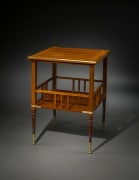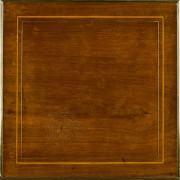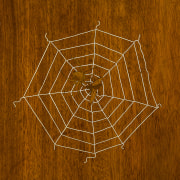Tiered Square Table in the Aesthetic Taste, about 1880
A. & H. Lejambre, Philadelphia
Mahogany, with fruitwood, inlays of pewter and exotic woods, brass over wood baguette moldings, and brass straps and sabots
27 1/4 in. high, 20 1/8 in. square
The attribution of this remarkable table to the Philadelphia firm of A. & H. Lejambre is based on the fact that it is very similar to one in the collection of The Metropolitan Museum of Art, New York (acc.no.1991.482), which bears a paper label of the firm. (A photograph of that table is in the Hirschl & Adler archives.) The tables vary in the use of legs that are round in plan in The Metropolitan Museum’s table and square in the present table, brass sabot that are curved in The Metropolitan Museum’s table and straight in the Hirschl & Adler table, and the three supports to the horizontal band above the medial shelf are round in plan and installed in a triangular pattern on The Metropolitan Museum table and square and installed vertically in the present table.
Both the style and the inlaid decoration on the present table and related examples reflect the Anglo-Japanesque influence of the English Aesthetic architect and designer, Edward William Godwin (1833–1886). Specifically, the clever balance, compositionally, of solids and voids, lights and darks, the overall lightness of scale, the asymmetry of the inlaid elements, the interplay of ornamented versus plain surfaces, and the use of aesthetic strap details and brass sabots, clearly illustrate the relationship between Godwin’s designs and those executed by Lejambre.






